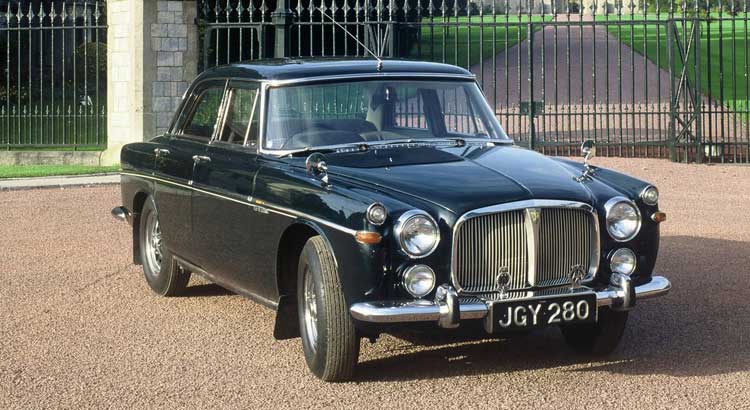Rover P5
The Rover P5 was a favourite of the middle class, film gangsters - and Her Majesty. By Martin Buckley

Few cars press as many nostalgic and emotional buttons as the Rover P5 and P5B. In sober saloon form it was the car of the bank manager and a vehicle of authority favoured by the government throughout the 1970s - the big shiny black saloon that swept up to No 10 on the TV news in times of national crisis. It spanned Harold Wilson (his 3-litre P5 had a special ashtray for his pipe) to the early days of Margaret Thatcher, who replaced the ageing cars in 1980 with the Daimler Double-Six.
As a coupe, with its rakish roofline and slender door frames, it took on an altogether more raffish character and was the favoured car of gangsters in films like Performance and Villain - squat and chunky on its glitzy Rostyle rims it exuded a well-bred menace.
The P5 story spans 15 years, 70,000 cars, two body style options and one major engine transplant. Dispensing at last with the separate chassis of the P4, the 3-litre P5 of 1958 was Rover's new flagship, its modern but dignified styling by David Bache, the man who later gave us the Rover 2000 and the Range Rover. His restrained shape was influenced by some Pininfarina one-offs on the P4 chassis, and certain contemporary US designs.
It had a traditional interior with African cherry wood on the dash, thick Wilton under-foot and leather almost everywhere else. On the road the 3-litre offered safe if uninspiring handling, great refinement and all the performance (around 100mph if you really must) traditional Rover buyers required from a virtually silent inlet-over-exhaust straight-six engine.
The 3-litre may not have been as exciting as a Jaguar, but it was probably built to a higher standard. It was certainly one of the world's best-made cars, and only Bentleys had a better pointed interior. The P5's cabin was a civilised world of fat club-land seating, adjustable armrests and a picnic table that doubled as a tool tray, sliding out neatly from under the dash. Rear passengers had their own separate heater.
At first nobody really minded that the 3-litre, joined by the hunch-roofed Coupe version in 1962, was a bit slow. The Queen certainly thought it adequate. She was often to be seen driving a P5 saloon when "off duty", and it is believed to be her favourite car to this day.
A couple of engine up-grades on MkII and III versions tried to address the power problem, but the 3-litre was never a road burner. Instead, enthusiastic Rover motorists were directed towards the sporty 2000TC P6.
By the mid 1960s, though, Rover bosses were beginning to realise that mere gravitas was not enough. Enter the Buick 3.5 V8 engine, a leftover from General Motors' brief flirtation with "compacts" in the early 1960s and acquired by Rover as an end-of-line bargain in 1966.
Packing 151bhp (the last 3-litres gave 134), it was a perfect fit under the P5's bonnet and gave this hefty car a whole new lease of life, pushing the top speed up to 110mph with vastly improved acceleration and slightly less thirst.
It also gave better handling because the all-alloy V8 was a lot lighter than old iron six, but this also meant that the power steering, already a little vague, was positively featherweight. While the old 3-litre had a manual option, all the V8s were automatic.
It was at this point that the car got its trademark Rostyle sports wheels. These rather rocked the establishment, the automotive equivalent of a middle-aged man suddenly ditching the Brylcreem, combing his hair forward and growing sideburns.
At once the big Rover (now codenamed P5B for Buick) was almost trendy, and at a shade under £2,000 Rover could barely keep pace with demand, which remained strong until the car's death in 1973. In a sense there was nothing to replace the P5 as a ministerial barge: no other British car being built in the 1970s had the same air of solid worth and dignity.
It is tempting to think of the Rover P5 and P5B as the poor man's Rolls-Royce, until one considers that a good example will match or exceed the price of a Silver Shadow. The V8 Coupe is easily the most favoured variant, particularly in the grey roof/navy bodywork livery that suits it so well. Chunky head restraints were one of the few options and are highly coveted. With them, the best P5B Coupes go for £12,000 or more.
Between £5,000 and £6,000 should buy a fairly nice example, but anything less probably means rust - and speaking as a multiple Rover Coupe owner I know what I'm talking about. The nice thing about the V8s is their useability. You still see plenty around because the light steering, effortless power and automatic gearboxes make them an easy drive for the classic car novice.
Value-for-money in the P5 world probably lies with the six cylinder models. They might be a little more leisurely, but they have a certain purist appeal with slightly better detailing than the V8s.
Good examples of all variants are hard to find, and most of the "one elderly owner" models have been snapped up. I know where there is a nice one, though: the ex-royal P5B saloon, the last of several owned by the Queen, sits in the BMHT Gaydon museum. Sadly, it is not for sale.
Subscribe to Independent Premium to bookmark this article
Want to bookmark your favourite articles and stories to read or reference later? Start your Independent Premium subscription today.

Join our commenting forum
Join thought-provoking conversations, follow other Independent readers and see their replies